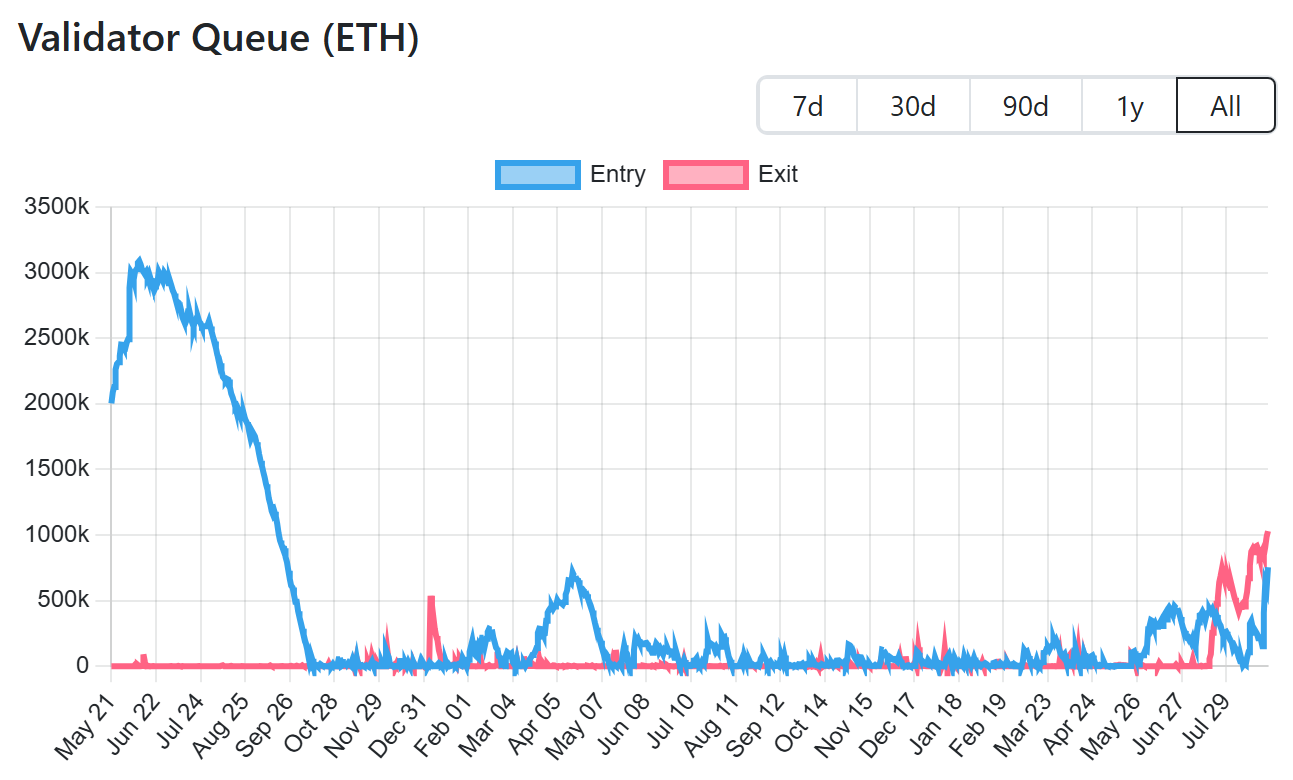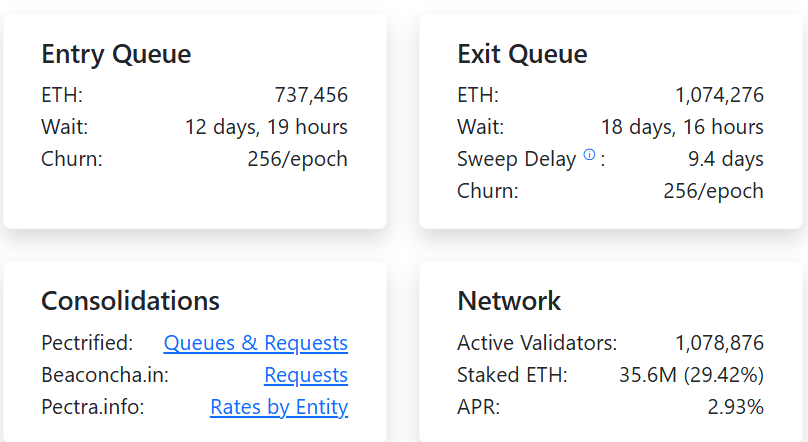The Ethereum exit queue has topped 1 million ETH (about $4.96B), extending the validator withdrawal wait to ~18 days. This 1 million Ether exit reflects increased validator withdrawals but does not by itself signal systemic selling; institutional demand and futures open interest are absorbing large flows.
-
1 million ETH queued for withdrawal
-
Validator exit wait time reached a record 18 days and 16 hours.
-
Ether futures open interest near $33 billion, showing strong institutional demand.
Meta description: Ethereum exit queue tops 1 million ETH; learn why this matters, how it affects liquidity, and what investors should watch next. Read analysis and key takeaways.
A significant portion of the almost $5 billion ETH awaiting withdrawal may be sold to lock in profits, considering Ether’s 72% climb over the past three months.
Ethereum is seeing the largest validator exodus in crypto history, with over 1 million Ether tokens currently waiting to be withdrawn from staking through Ethereum’s proof-of-stake (PoS) network.
Ethereum’s exit queue surpassed 1 million Ether (ETH) worth $4.96 billion on Thursday. This marks the amount of Ether set for withdrawal by the network’s validators, who are responsible for adding new blocks and verifying transactions in proposed blocks, playing a vital role in the functioning of the blockchain network.
The mass exodus has extended the validator exit waiting time to a record 18 days and 16 hours, according to blockchain data from validatorqueue.
While this does not mean that all the validators are looking to sell their holdings, a significant portion of the almost $5 billion may be sold to lock in profits, considering that Ether has risen 72% over the past three months.

Ether validator queue. Source: validatorqueue.com
“The exit queue hitting 1 million ETH reflects healthy market dynamics rather than a cause for concern,” Marcin Kazmierczak, co-founder of RedStone blockchain oracle firm, told Cointelegraph, adding:
“What’s crucial to understand is that these exits pale in comparison to the institutional capital flowing into Ethereum.”
The “unprecedented demand” from public vehicles such as treasury firms and exchange-traded funds means that the validator sales are “easily absorbed by this institutional appetite,” he said.
Related: Kanye West’s YZY token: 51,000 traders lost $74M, while 11 netted $1M (plain text reference)
What is the Ethereum exit queue and why has it hit 1 million ETH?
The Ethereum exit queue is the backlog of validators requesting withdrawals from staking; the queue reached over 1 million ETH, pushing average withdrawal wait times to about 18 days. Validators enqueue withdrawals for many reasons, including profit-taking after a 72% price surge in the last three months.
How does the exit queue affect market liquidity?
Large queued withdrawals increase potential selling pressure if validators choose to liquidate. However, institutional demand, shown by near $33 billion in Ether futures open interest, can absorb sizable flows. Short-term prices may see volatility, but deep liquidity pools and exchange-traded vehicles help stabilize order books.
What are current network health metrics?
Network fundamentals remain strong. There are over 1 million active validators and 35.6 million Ether staked, representing over 29.4% of total supply. The entry queue holds about 737,000 ETH with an average wait time near 12 days and 19 hours, indicating ongoing staking demand alongside exits.

Ether validator and exit queue. Source: validatorqueue.com
Why might validators sell after exiting?
Validators may sell to lock in gains after Ether’s recent rally. Price appreciation, operational costs, or portfolio rebalancing are common drivers. Market observers point to profit-taking behavior given the 72% rise over three months, but selling is not guaranteed for every exiting validator.
What signals should investors watch next?
- Validator exit queue size and average wait times (daily updates from on-chain monitors).
- Ether futures open interest and funding rates for indications of institutional positioning.
- Macroeconomic releases such as US jobless claims and the PCE inflation gauge that can influence risk asset flows.
Frequently Asked Questions
How long will validators wait to withdraw their ETH?
The current average withdrawal wait is about 18 days and 16 hours, based on the exit queue size and the protocol’s throughput for processing exits.
Does 1 million ETH in the exit queue mean a market crash is coming?
Not necessarily. While large exits raise selling risk, institutional demand and substantial futures open interest help absorb flows. Network fundamentals remain robust with over 1 million active validators.
How much ETH is being staked versus withdrawn?
Approximately 35.6 million ETH are actively staked on the network. The exit queue holds ~1 million ETH, while the entry queue has roughly 737,000 ETH awaiting staking.
Key Takeaways
- Queue size: Over 1 million ETH queued for withdrawal (~$4.96B).
- Market context: Ether futures open interest near $33B underlines strong institutional involvement.
- Investor action: Monitor on-chain exit and entry queue metrics, futures positioning, and macro data for short-term risk signals.
Conclusion
The Ethereum exit queue topping 1 million ETH highlights active validator rotation but does not automatically indicate systemic distress. With robust staking levels, significant institutional demand, and deep derivatives liquidity, the market can absorb sizable flows. Watch queue dynamics and macro releases; consider this a liquidity event to monitor, not a decisive sell signal.







